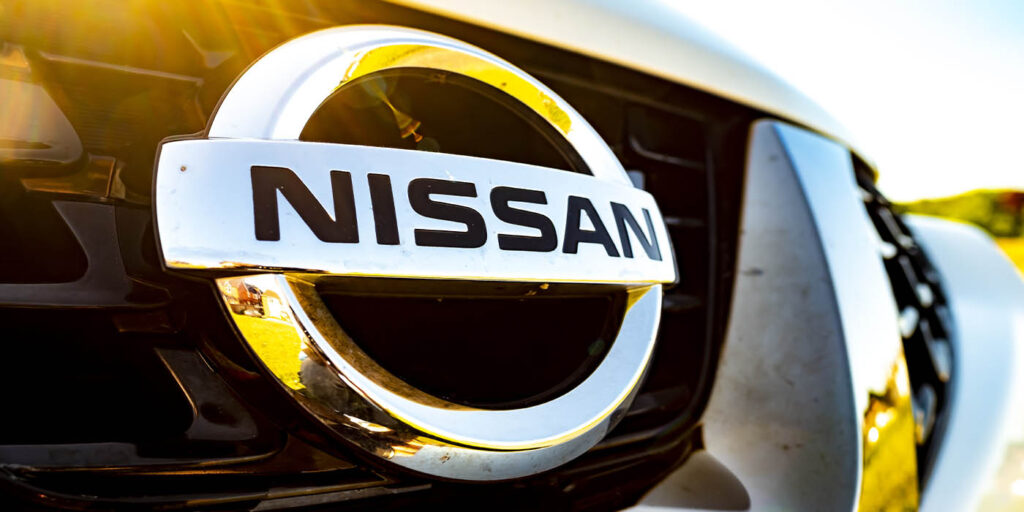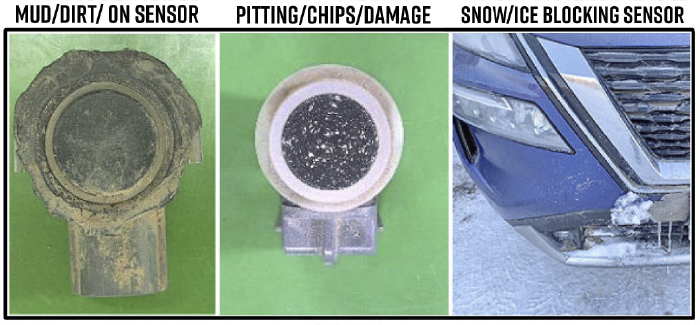INCORRECT FRONT/REAR SONAR SENSOR OPERATION
Models
All Nissans with Sonar Sensors
Sonar sensors use ultrasonic sound waves to detect objects and distance. If a sonar sensor’s visible surface has been damaged or is partially, or totally, obstructed by mud/dirt, road debris, bugs, snow or ice, the sound waves that are being transmitted can be muted, redirected, absorbed, and not received. Possible causes of incorrect sensor (sonar sensor) operation include:
- Object not within the detection range of the sensors.
- Sensor range sensitivity setting is set too sensitive, or not sensitive enough.
- Objects that cannot be detected by the sensors.
- Foreign material (mud/dirt, road debris, bugs, snow or ice, etc.) attached to any of the sensors, or their surroundings.
- Damage to one or more of the sensors, or the area around the sensors.
- Items installed around one or more sensor (e.g. Accessories or bumper protectors, etc.).
- The vehicle ride height has been altered.
If the sonar sensor is not detecting objects, even though there are objects present, first confirm:
Is there foreign material attached to any of the sensors, or their surroundings?
Make sure all sensors are clean, and that built up debris is not present surrounding the sensors prior to testing.
Is the object within the detection range of the sensor?
Each sensor has a specific detection area and a maximum range. If the object is outside of the following detection ranges, the sensor will not be able to detect it.
Front or rear corner sensor: 2 feet
Front center sensor: 3.3 feet
Rear center sensor: 5 feet
Does the vehicle have an adjustable sensor range setting?
Access the vehicle options menu, check if the vehicle has an adjustable range setting and set it to the maximum distance to ensure the sensors are picking up objects.
Is it an object that can be detected by the sensor?
Because the sensors detect the position of obstacles by emitting and then receiving ultrasonic soundwaves, the sensors cannot detect obstacles that absorb, or do not reflect, these waves.
EXAMPLES: (Figure 1)
• Non-solid objects like chain link fences, or snowbanks.
• Sensors also may not be able to detect lower height objects, such as curbs or flower beds.
If the sonar sensor is detecting objects, even though there are no objects present, and/or triggering a warning or malfunction light.
Is there any foreign material (mud/dirt, road debris, bugs, snow or ice, etc.) attached to any of the sensors, or their surroundings?
Make sure all sensors are clean prior to testing. The sensors may react to foreign material and cause a false detection alert (Figure 2).
Is there any damage to one or more of the sensors, or the area around the sensors?
Scratches or dents on the surface of the sensor may cause it to not operate, or falsely detect objects. Damage to the bumper cover surrounding the sensor may affect the alignment of one or more sensors.
Is there anything installed around one or more sensor accessories or bumper protectors?
Test sensors with these objects removed or repositioned.
Has the vehicle ride height been altered?
If the vehicle ride height is below the published specifications (see ESM), due to wheel and/or suspension changes, or because of low tire pressure, the sensor may detect the road surface or objects that are not normally detected.
















